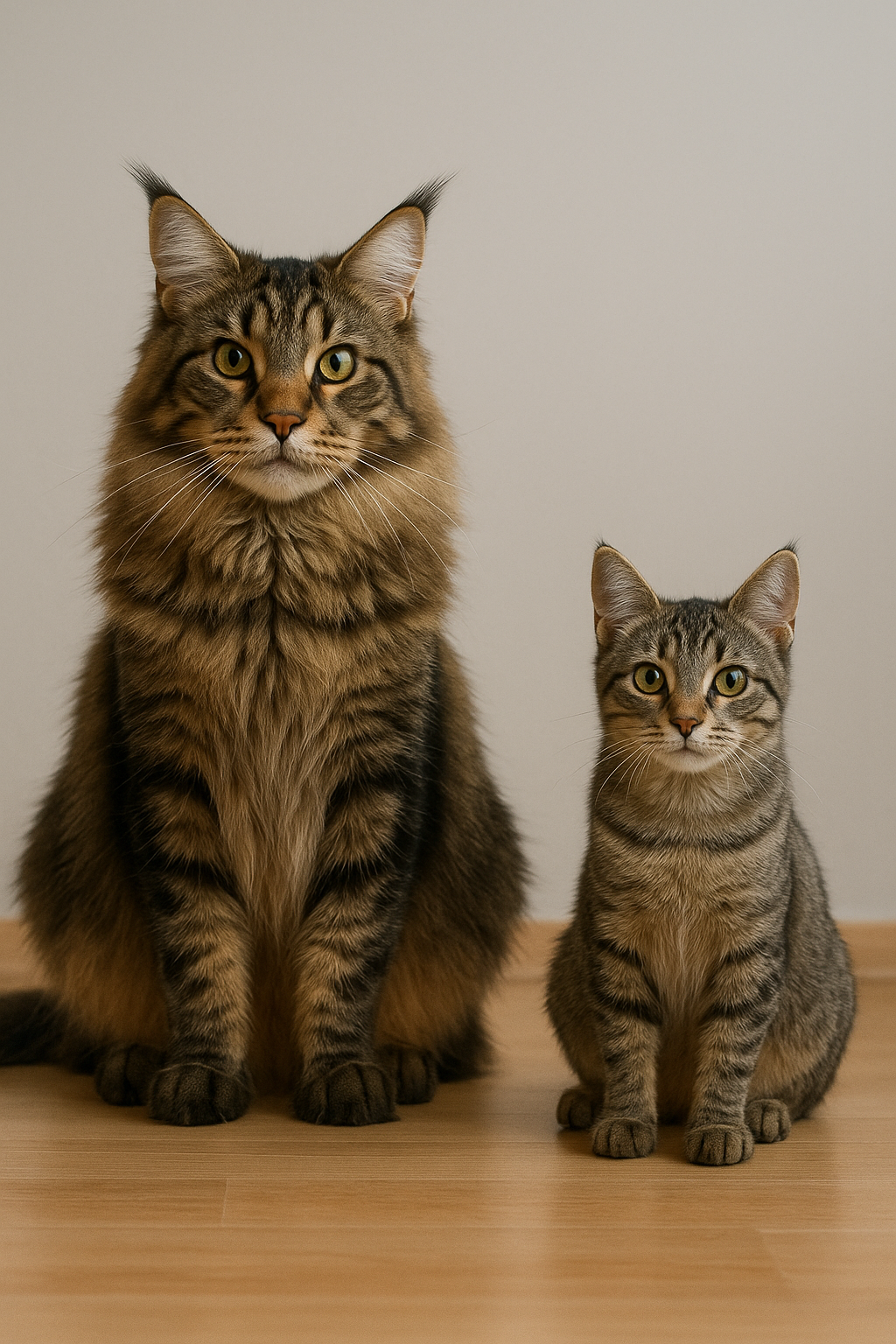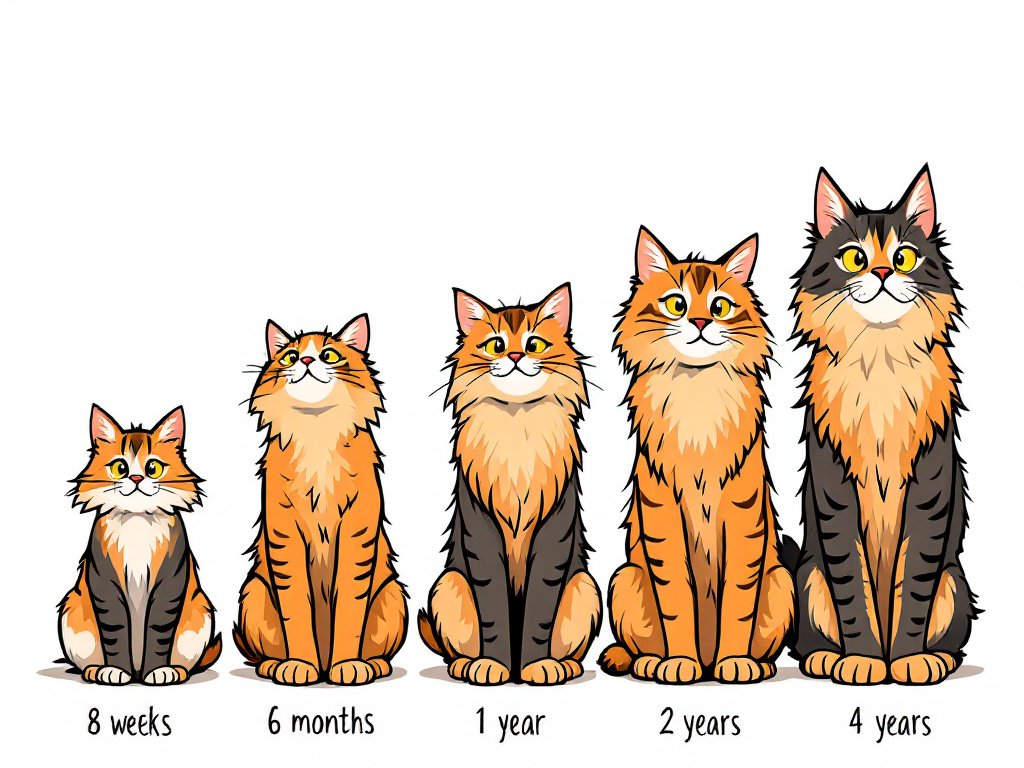
Maine Coons are renowned for their impressive size, often described as "gentle giants" of the cat world. If you're considering welcoming one of these magnificent felines into your home, understanding their growth pattern and eventual size is crucial. This comprehensive guide provides detailed Maine Coon size charts, growth milestones, and factors that influence their development.
Considering a Maine Coon Kitten?
Our carefully bred Maine Coons come from champion bloodlines with optimal size and health characteristics.
View Available KittensMaine Coon Growth Chart: From Kitten to Adult
Maine Coons have a longer growth period than most cat breeds, typically reaching their full size between 3-5 years. Here's what to expect at each stage:
| Age | Male Weight | Female Weight | Length | Developmental Stage |
|---|---|---|---|---|
| 3 Months | 4-6 lbs (1.8-2.7 kg) | 3-5 lbs (1.4-2.3 kg) | 14-18 inches (35-45 cm) | Rapid growth phase begins |
| 6 Months | 9-12 lbs (4-5.5 kg) | 7-10 lbs (3-4.5 kg) | 22-28 inches (55-70 cm) | Teenage lankiness appears |
| 1 Year | 12-16 lbs (5.5-7.5 kg) | 9-12 lbs (4-5.5 kg) | 30-36 inches (75-90 cm) | Approaching adult length |
| 2 Years | 15-20 lbs (7-9 kg) | 10-14 lbs (4.5-6.5 kg) | 35-40 inches (88-100 cm) | Filling out, muscle development |
| 3-5 Years | 15-25 lbs (7-11.5 kg) | 10-15 lbs (4.5-7 kg) | 40-48 inches (100-120 cm) | Fully mature size reached |

Key Takeaway:
Maine Coons grow for 3-5 years, significantly longer than most cats who reach full size at 1-2 years. This extended growth period contributes to their large bone structure and substantial muscle mass.
Factors That Influence Maine Coon Size
While genetics play the primary role in determining your Maine Coon's eventual size, several other factors can influence their growth:
1. Genetics and Bloodlines
The size of a Maine Coon's parents is the strongest predictor of their adult size. Reputable breeders selectively breed for healthy, standard-sized cats. European bloodlines often produce larger Maine Coons, while American lines may be slightly smaller but still substantial.
2. Nutrition
Proper nutrition during the growth phase is critical. Maine Coons require:
- High-quality protein (40-50% of diet)
- Moderate fat content (18-20%)
- Essential fatty acids for joint health
- Appropriate calcium-phosphorus ratio
- Controlled calorie intake to prevent obesity

3. Gender Differences
Male Maine Coons are typically 30-40% larger than females. While females are still substantial cats, males often have broader heads, thicker necks, and more muscular bodies. This sexual dimorphism is more pronounced in Maine Coons than in most other cat breeds.
4. Health Factors
Certain health issues can affect growth. Regular veterinary checkups can identify and address:
- Hip dysplasia (more common in large breeds)
- Hypertrophic cardiomyopathy (HCM)
- Intestinal parasites that can stunt growth
- Dental issues that affect eating
Ensure Healthy Growth With Our Guidance
Our breeding program focuses on health and proper size development. We provide detailed care instructions with each kitten.
Speak With Our BreedersMaine Coon Size Comparison With Other Breeds
To truly appreciate the size of Maine Coons, it helps to compare them with other popular cat breeds:
| Breed | Average Weight | Average Length | Size Comparison |
|---|---|---|---|
| Maine Coon | 13-18 lbs (6-8 kg) | 40-48 inches (100-120 cm) | Largest domestic cat breed |
| Norwegian Forest Cat | 12-16 lbs (5.5-7 kg) | 36-42 inches (90-105 cm) | Similar length, slightly lighter build |
| Ragdoll | 12-16 lbs (5.5-7 kg) | 34-40 inches (85-100 cm) | Substantial but less muscular |
| Savannah Cat | 12-20 lbs (5.5-9 kg) | 35-45 inches (88-112 cm) | Similar weight, more slender build |
| Domestic Shorthair | 8-10 lbs (3.5-4.5 kg) | 28-32 inches (70-80 cm) | Significantly smaller in all dimensions |

Frequently Asked Questions About Maine Coon Size
Maine Coons reach their full length and height by 3-4 years of age but may continue to fill out and gain muscle mass until they are 5 years old. This extended growth period is one reason they become so large compared to other cat breeds.
A good rule of thumb is to double your Maine Coon's weight at 4 months to estimate their adult weight. Genetics play the largest role, so looking at the size of the kitten's parents can give you the best prediction of their eventual size.
Male Maine Coons are typically significantly larger than females. Adult males usually weigh 15-25 pounds, while females typically range from 10-15 pounds. This size difference is one of the most pronounced among domestic cat breeds.
The Guinness World Record for the longest domestic cat belongs to a Maine Coon named Barivel, who measured 120cm (3ft 11.2in) from nose to tail tip. Other Maine Coons have reached weights of over 30 pounds, though such extreme sizes are rare.
Professional Insight:
"While people often focus on the impressive size of Maine Coons, responsible breeding prioritizes health and proportionality over extreme size. A healthy, well-structured Maine Coon with good muscle tone is more important than simply achieving maximum weight or length." - RoyalPaws Breeding Philosophy
Preparing Your Home for a Large Breed Cat
Their substantial size means Maine Coons have different requirements than average cats:
Furniture and Equipment
- Extra-large litter boxes: Minimum 22" x 18" dimensions
- Sturdy, wide cat trees: With platforms that support 25+ pounds
- Oversized carriers: Dog carriers often work better than cat carriers
- Large food and water bowls: Wide, shallow bowls to prevent whisker fatigue
Space Considerations
- Vertical space for climbing (they enjoy high perches)
- Open floor space for play and exercise
- Multiple resting spots throughout your home
- Secure screening on windows (their weight can compromise weak screens)

Ready for a Maine Coon?
Our kittens are bred for health, temperament, and proper conformation. Contact us to learn more about our available Maine Coons.
View Kittens Ask QuestionsMonitoring Your Maine Coon's Growth and Health
Regular monitoring ensures your Maine Coon is growing at a healthy rate:
Weight Tracking
Weigh your Maine Coon monthly during their first two years, then quarterly until age five. Keep a growth chart to monitor their progress against typical milestones.
Body Condition Scoring
Learn to assess your cat's body condition:
- You should be able to feel but not see their ribs
- They should have a visible waist when viewed from above
- Abdomen should tuck up when viewed from the side
- No fat deposits over the base of the tail
Veterinary Care
Regular vet checkups are essential for large breed cats. Discuss:
- Appropriate diet for their growth stage
- Joint health supplements if recommended
- Screening for breed-specific conditions
- Dental care (large cats can have more dental issues)
Final Thoughts:
While the impressive size of Maine Coons is certainly attention-grabbing, their true appeal lies in their wonderful temperament, intelligence, and affectionate nature. Whether your Maine Coon reaches the upper limits of the breed standard or settles comfortably in the average range, their larger-than-life personality will undoubtedly fill your home with joy.
